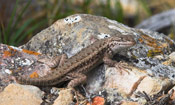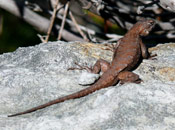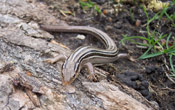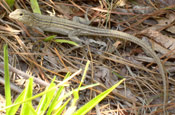South Dakota Lizards

Lesser or Northern Earless Lizard
(Holbrookia m. maculata)
Lesser earless lizards have no external ear openings, which may be an adaptation to this lizard's practice of burrowing headfirst into sand. They can usually be found in a narrow band along extreme southern South Dakota in sandhills, sandy, or gravel-covered areas along streams, as well as plains, and grassland offering an abundance of open space.

Eastern Short-horned Lizard
(Phrynosoma douglasi brevirostre)
Short-horned lizards are relatively flat, round lizards with short, stubby horns above the eyes and around the back of the head, and have many small, triangular fringes along the sides of the body. When disturbed by predators, horned lizards occasionally squirt blood from the eyes for distances of up to 2-3 feet. Although it is rare to spot one in South Dakota, there is a population of these lizards in southwestern South Dakota and another in the northwestern part of the state.

Northern Sagebrush Lizard
(Sceloporus g. graciosus)
Named after the sagebrush plants near where it is commonly found, the Sagebrush Lizard is an easily frightened animal that seeks shelter when large animals approach. Due to their skittish nature, these lizards do not typically interact with humans. They are rare in South Dakota but can be found in a small range in the western and southern Black Hills.

Northern Prairie Lizard
(Sceloporus undulatus garmani)
The Northern Prairie Lizard is a medium-sized lizard found along forest edges, rock piles, and rotting logs or stumps. They are sometimes called the Eastern Fence Lizard or Gray Lizard. They can be found in a narrow band along south-central South Dakota.
Northern Many-lined Skink
(Eumeces m. multivirgatus)
The Northern Many-lined Skink is a skinny long-bodied lizard. As its name implies, most many-lined skinks have dark and light stripes that run lengthwise down the body and tail. The Northern Many-lined Skink can be found in many types of habitat, but the species prefers moist areas and areas near water. They have a narrow range in southwest and lower central South Dakota.

Northern Prairie Skink
(Eumeces septentrionalis)
Found in extreme eastern South Dakota, these small lizards are brown or tan on the back and darker on the sides and have several thin lighter stripes along the sides and the back. They are very secretive and are rarely seen in the open except during their breeding season in spring.

Prairie Six-lined Racerunner
(Cnemidophorus sexlineatus viridis)
This lizard is named for the six light stripes that run along the sides of its body. The color of the stripes ranges in color from pale blue, grey, white or yellow. Females have white bellies, and males have blue. They can be found in southwest and lower central South Dakota and one miniscule range in the extreme southeast part of the state.

Visit our Sky Dome and experience free-roaming lizards, birds, turtles and a few friendly snakes on the main level. Head to the upper level to check out the collection of some of the world’s deadliest snakes. The lower level of the Sky Dome contains Maniac, our giant crocodile and other crocodilians, our collection of frogs & toads , bugs, and salamander.







